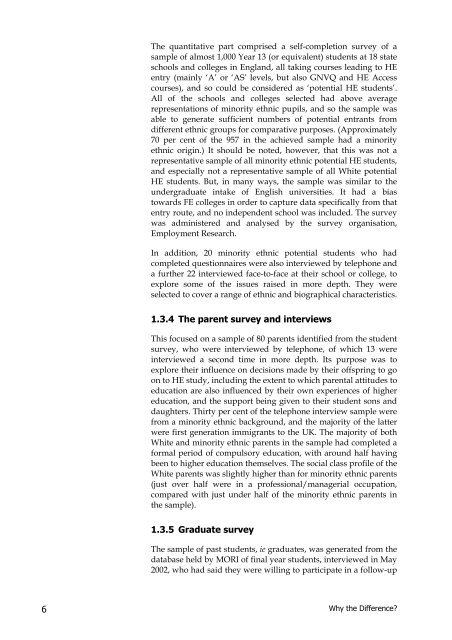A Closer Look at Higher Education Minority Ethnic Students and ...
A Closer Look at Higher Education Minority Ethnic Students and ...
A Closer Look at Higher Education Minority Ethnic Students and ...
You also want an ePaper? Increase the reach of your titles
YUMPU automatically turns print PDFs into web optimized ePapers that Google loves.
The quantit<strong>at</strong>ive part comprised a self-completion survey of asample of almost 1,000 Year 13 (or equivalent) students <strong>at</strong> 18 st<strong>at</strong>eschools <strong>and</strong> colleges in Engl<strong>and</strong>, all taking courses leading to HEentry (mainly ‘A’ or ‘AS’ levels, but also GNVQ <strong>and</strong> HE Accesscourses), <strong>and</strong> so could be considered as ‘potential HE students’.All of the schools <strong>and</strong> colleges selected had above averagerepresent<strong>at</strong>ions of minority ethnic pupils, <strong>and</strong> so the sample wasable to gener<strong>at</strong>e sufficient numbers of potential entrants fromdifferent ethnic groups for compar<strong>at</strong>ive purposes. (Approxim<strong>at</strong>ely70 per cent of the 957 in the achieved sample had a minorityethnic origin.) It should be noted, however, th<strong>at</strong> this was not arepresent<strong>at</strong>ive sample of all minority ethnic potential HE students,<strong>and</strong> especially not a represent<strong>at</strong>ive sample of all White potentialHE students. But, in many ways, the sample was similar to theundergradu<strong>at</strong>e intake of English universities. It had a biastowards FE colleges in order to capture d<strong>at</strong>a specifically from th<strong>at</strong>entry route, <strong>and</strong> no independent school was included. The surveywas administered <strong>and</strong> analysed by the survey organis<strong>at</strong>ion,Employment Research.In addition, 20 minority ethnic potential students who hadcompleted questionnaires were also interviewed by telephone <strong>and</strong>a further 22 interviewed face-to-face <strong>at</strong> their school or college, toexplore some of the issues raised in more depth. They wereselected to cover a range of ethnic <strong>and</strong> biographical characteristics.1.3.4 The parent survey <strong>and</strong> interviewsThis focused on a sample of 80 parents identified from the studentsurvey, who were interviewed by telephone, of which 13 wereinterviewed a second time in more depth. Its purpose was toexplore their influence on decisions made by their offspring to goon to HE study, including the extent to which parental <strong>at</strong>titudes toeduc<strong>at</strong>ion are also influenced by their own experiences of highereduc<strong>at</strong>ion, <strong>and</strong> the support being given to their student sons <strong>and</strong>daughters. Thirty per cent of the telephone interview sample werefrom a minority ethnic background, <strong>and</strong> the majority of the l<strong>at</strong>terwere first gener<strong>at</strong>ion immigrants to the UK. The majority of bothWhite <strong>and</strong> minority ethnic parents in the sample had completed aformal period of compulsory educ<strong>at</strong>ion, with around half havingbeen to higher educ<strong>at</strong>ion themselves. The social class profile of theWhite parents was slightly higher than for minority ethnic parents(just over half were in a professional/managerial occup<strong>at</strong>ion,compared with just under half of the minority ethnic parents inthe sample).1.3.5 Gradu<strong>at</strong>e surveyThe sample of past students, ie gradu<strong>at</strong>es, was gener<strong>at</strong>ed from thed<strong>at</strong>abase held by MORI of final year students, interviewed in May2002, who had said they were willing to particip<strong>at</strong>e in a follow-up6Why the Difference?
















